 |
 |
Our enthusiastic and extremely knowledgeable perennials team is here to answer your questions and help you choose the best perennials for your situation. There’s always something in bloom for sun, shade, butterflies, birds or deer resistance as well as a variety of bulbs for your space.
Stroll through our time-tested favorites and introduce yourself to the newest varieties. We garden with perennials too; we love them and it shows!
|
116 found, showing page 1 of 8

Purple-red blooms. Upright dark green-purple foliage. USDA 4-8

Plant Height: 12 inches
Flower Height: 18 inches
Spacing: 18 inches
Sunlight: partial shade full shade
Hardiness Zone: 2b
Other Names: False Spirea
Description:
An upright-mounded, low maintenance and shade loving variety; pure white plumes rise above mounds of ferny foliage; an excellent addition to shaded gardens, borders, containers or moon gardens; low maintenance
Ornamental Features:
Bridal Veil Astilbe has masses of beautiful plumes of white flowers at the ends of the stems from late spring to early summer, which are most effective when planted in groupings. The flowers are excellent for cutting. Its ferny compound leaves remain emerald green in color throughout the season.
Landscape Attributes:
Bridal Veil Astilbe is an herbaceous perennial with an upright spreading habit of growth. Its relatively fine texture sets it apart from other garden plants with less refined foliage.
This is a relatively low maintenance plant, and is best cleaned up in early spring before it resumes active growth for the season. It is a good choice for attracting butterflies to your yard, but is not particularly attractive to deer who tend to leave it alone in favor of tastier treats. It has no significant negative characteristics.
Bridal Veil Astilbe is recommended for the following landscape applications:
- Mass Planting
- Rock/Alpine Gardens
- Border Edging
- General Garden Use
- Container Planting
- Planting & Growing
Bridal Veil Astilbe will grow to be about 12 inches tall at maturity extending to 18 inches tall with the flowers, with a spread of 24 inches. When grown in masses or used as a bedding plant, individual plants should be spaced approximately 18 inches apart. Its foliage tends to remain dense right to the ground, not requiring facer plants in front. It grows at a medium rate, and under ideal conditions can be expected to live for approximately 10 years. As an herbaceous perennial, this plant will usually die back to the crown each winter, and will regrow from the base each spring. Be careful not to disturb the crown in late winter when it may not be readily seen!
This plant does best in partial shade to shade. It requires an evenly moist well-drained soil for optimal growth. It is very fussy about its soil conditions and must have rich, acidic soils to ensure success, and is subject to chlorosis (yellowing) of the foliage in alkaline soils. It is somewhat tolerant of urban pollution, and will benefit from being planted in a relatively sheltered location. Consider applying a thick mulch around the root zone over the growing season to conserve soil moisture. This particular variety is an interspecific hybrid. It can be propagated by division; however, as a cultivated variety, be aware that it may be subject to certain restrictions or prohibitions on propagation.
Bridal Veil Astilbe is a fine choice for the garden, but it is also a good selection for planting in outdoor pots and containers. It is often used as a 'filler' in the 'spiller-thriller-filler' container combination, providing a mass of flowers against which the larger thriller plants stand out. Note that when growing plants in outdoor containers and baskets, they may require more frequent waterings than they would in the yard or garden.
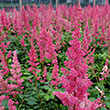
Magenta blooms. tolerates deer, heavy shade, & black walnut. USDA 3-8
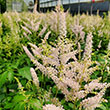
Delicate pinky peach flower spikes crown lacy green leaves. Tolerates deer, heavy shade, and black walnut. USDA 4-8

Pink blooms. Tolerates deer, heavy shade, & black walnut. USDA 4-8
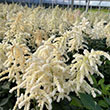
Soft, feathery, white flower heads bloom through the summer. Deer and rabbit resistant. USDA 4-9
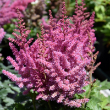
Plant Height: 10 inches
Flower Height: 14 inches
Spacing: 12 inches
Sunlight: partial shade, full shade
Hardiness Zone: 3a
Other Names: False Spirea
Description:
This dwarf variety produces showy light pink plumes, rising above deep green leaves; dense, upright form; perfect in a shady spot with dappled light; prefers moisture so water regularly for abundant flowers and nice foliage
Ornamental Features:
Little Vision In Pink Chinese Astilbe has masses of beautiful plumes of pink flowers at the ends of the stems from mid to late summer, which are most effective when planted in groupings. The flowers are excellent for cutting. Its ferny compound leaves remain dark green in color throughout the season.
Landscape Attributes:
Little Vision In Pink Chinese Astilbe is an herbaceous perennial with an upright spreading habit of growth. Its relatively fine texture sets it apart from other garden plants with less refined foliage.
This is a relatively low maintenance plant, and is best cleaned up in early spring before it resumes active growth for the season. It is a good choice for attracting butterflies to your yard, but is not particularly attractive to deer who tend to leave it alone in favor of tastier treats. It has no significant negative characteristics.
Little Vision In Pink Chinese Astilbe is recommended for the following landscape applications:
- Mass Planting
- Border Edging
- General Garden Use
- Container Planting
- Planting & Growing
Little Vision In Pink Chinese Astilbe will grow to be about 10 inches tall at maturity extending to 14 inches tall with the flowers, with a spread of 16 inches. When grown in masses or used as a bedding plant, individual plants should be spaced approximately 12 inches apart. Its foliage tends to remain low and dense right to the ground. It grows at a medium rate, and under ideal conditions can be expected to live for approximately 10 years. As an herbaceous perennial, this plant will usually die back to the crown each winter, and will regrow from the base each spring. Be careful not to disturb the crown in late winter when it may not be readily seen!
This plant does best in partial shade to shade. It requires an evenly moist well-drained soil for optimal growth. It is very fussy about its soil conditions and must have rich, acidic soils to ensure success, and is subject to chlorosis (yellowing) of the foliage in alkaline soils. It is somewhat tolerant of urban pollution, and will benefit from being planted in a relatively sheltered location. Consider applying a thick mulch around the root zone over the growing season to conserve soil moisture. This is a selected variety of a species not originally from North America. It can be propagated by division; however, as a cultivated variety, be aware that it may be subject to certain restrictions or prohibitions on propagation.
Little Vision In Pink Chinese Astilbe is a fine choice for the garden, but it is also a good selection for planting in outdoor pots and containers. It is often used as a 'filler' in the 'spiller-thriller-filler' container combination, providing a mass of flowers against which the larger thriller plants stand out. Note that when growing plants in outdoor containers and baskets, they may require more frequent waterings than they would in the yard or garden.
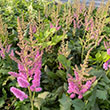
Pink blooms. Dwarf. Tolerates heavy shade, Wet sites & deer. USDA 4-8
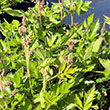
Pink blooms. Tolerates heavy shade, deer, & black walnut. USDA 4-8
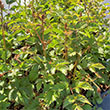
Purple to red blooms and dark green upright foliage. Perfers moist soil. USDA 4-8
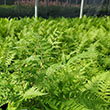
Tolerates rabbits & deep shade. Upright, vase-shape. USDA 4-8
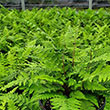
Height: 18 inches
Spread: 24 inches
Sunlight: partial shade, full shade
Hardiness Zone: 2b
Description:
An excellent choice for adding fine texture to garden beds and borders; features a low growing habit with arching green fronds throughout the season; easy to grow, requiring little to no maintenance; prefers partial to full shaded areas
Ornamental Features:
Lady Fern is primarily valued in the garden for its cascading habit of growth. Its ferny bipinnately compound leaves remain green in color throughout the season.
Landscape Attributes:
Lady Fern is a dense herbaceous fern with a shapely form and gracefully arching fronds. It brings an extremely fine and delicate texture to the garden composition and should be used to full effect.
This is a relatively low maintenance plant, and usually looks its best without pruning, although it will tolerate pruning. Deer don't particularly care for this plant and will usually leave it alone in favor of tastier treats. It has no significant negative characteristics.
Lady Fern is recommended for the following landscape applications:
- Mass Planting
- Border Edging
- General Garden Use
- Groundcover
- Naturalizing And Woodland Gardens
Planting & Growing:
Lady Fern will grow to be about 18 inches tall at maturity, with a spread of 24 inches. Its foliage tends to remain dense right to the ground, not requiring facer plants in front. It grows at a slow rate, and under ideal conditions can be expected to live for approximately 15 years. As an herbaceous perennial, this plant will usually die back to the crown each winter, and will regrow from the base each spring. Be careful not to disturb the crown in late winter when it may not be readily seen!
This plant does best in partial shade to shade. It prefers to grow in moist to wet soil, and will even tolerate some standing water. It is particular about its soil conditions, with a strong preference for rich, acidic soils. It is somewhat tolerant of urban pollution, and will benefit from being planted in a relatively sheltered location. Consider applying a thick mulch around the root zone over the growing season to conserve soil moisture. This species is not originally from North America, and parts of it are known to be toxic to humans and animals, so care should be exercised in planting it around children and pets. It can be propagated by division.
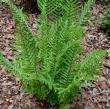
Erect, vase shaped. Narrow lanceolate fronds. USDA 5-8
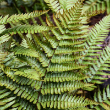
Height: 18 inches
Spread: 18 inches
Sunlight: partial shade, full shade
Hardiness Zone: 4b
Other Names: Japanese Red Shield Fern
Description:
Gorgeous dramatic foliage color on spreading plants, ideal for borders, containers or use as groundcover; young papery fronds emerge copper in color and develop to green when mature; easy to grow and drought resistant
Ornamental Features:
Autumn Fern is primarily valued in the garden for its broadly spreading habit of growth. Its attractive glossy ferny compound leaves emerge coppery-bronze in spring, turning forest green in color with prominent coppery-bronze tips the rest of the year.
Landscape Attributes:
Autumn Fern is a dense herbaceous evergreen fern with a ground-hugging habit of growth. It brings an extremely fine and delicate texture to the garden composition and should be used to full effect.
This is a relatively low maintenance plant, and should be cut back in late fall in preparation for winter. Deer don't particularly care for this plant and will usually leave it alone in favor of tastier treats. It has no significant negative characteristics.
Autumn Fern is recommended for the following landscape applications:
- Mass Planting
- Rock/Alpine Gardens
- Border Edging
- General Garden Use
- Groundcover
- Naturalizing And Woodland Gardens
- Container Planting
Planting & Growing:
Autumn Fern will grow to be about 18 inches tall at maturity, with a spread of 18 inches. Its foliage tends to remain dense right to the ground, not requiring facer plants in front. It grows at a medium rate, and under ideal conditions can be expected to live for approximately 15 years. As an evegreen perennial, this plant will typically keep its form and foliage year-round.
This plant does best in partial shade to shade. It is quite adaptable, prefering to grow in average to wet conditions, and will even tolerate some standing water. It is particular about its soil conditions, with a strong preference for rich, acidic soils. It is somewhat tolerant of urban pollution, and will benefit from being planted in a relatively sheltered location. Consider applying a thick mulch around the root zone over the growing season to conserve soil moisture. This species is not originally from North America, and parts of it are known to be toxic to humans and animals, so care should be exercised in planting it around children and pets. It can be propagated by division.
Autumn Fern is a fine choice for the garden, but it is also a good selection for planting in outdoor pots and containers. Because of its spreading habit of growth, it is ideally suited for use as a 'spiller' in the 'spiller-thriller-filler' container combination; plant it near the edges where it can spill gracefully over the pot. Note that when growing plants in outdoor containers and baskets, they may require more frequent waterings than they would in the yard or garden.
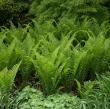
Height: 24 inches
Spacing: 3 feet
Sunlight: full sun, partial shade, full shade
Hardiness Zone: 1b
Description:
The most common and recognizable of the ferns, this is a very tough and hardy plant, featuring tall lacy fronds all season long; spreads aggressively and may require some control; grows best in shade with rich, moist soil; great for textural effect
Ornamental Features:
Ostrich Fern is primarily valued in the garden for its ornamental upright and spreading habit of growth. Its large fragrant ferny compound leaves remain light green in color throughout the season.
Landscape Attributes:
Ostrich Fern is an herbaceous fern with an upright spreading habit of growth. Its relatively fine texture sets it apart from other garden plants with less refined foliage.
This is a high maintenance plant that will require regular care and upkeep, and is best cleaned up in early spring before it resumes active growth for the season. Deer don't particularly care for this plant and will usually leave it alone in favor of tastier treats. Gardeners should be aware of the following characteristic(s) that may warrant special consideration:
- Invasive
Ostrich Fern is recommended for the following landscape applications:
- Mass Planting
- General Garden Use
- Groundcover
- Naturalizing And Woodland Gardens
Planting & Growing:
Ostrich Fern will grow to be about 24 inches tall at maturity, with a spread of 4 feet. When grown in masses or used as a bedding plant, individual plants should be spaced approximately 3 feet apart. It tends to be leggy, with a typical clearance of 1 foot from the ground, and should be underplanted with lower-growing perennials. It grows at a fast rate, and under ideal conditions can be expected to live for approximately 20 years. As an herbaceous perennial, this plant will usually die back to the crown each winter, and will regrow from the base each spring. Be careful not to disturb the crown in late winter when it may not be readily seen!
This plant performs well in both full sun and full shade. It is an amazingly adaptable plant, tolerating both dry conditions and even some standing water. It is not particular as to soil pH, but grows best in rich soils. It is highly tolerant of urban pollution and will even thrive in inner city environments. This species is native to parts of North America. It can be propagated by division.
116 found, showing page 1 of 8













